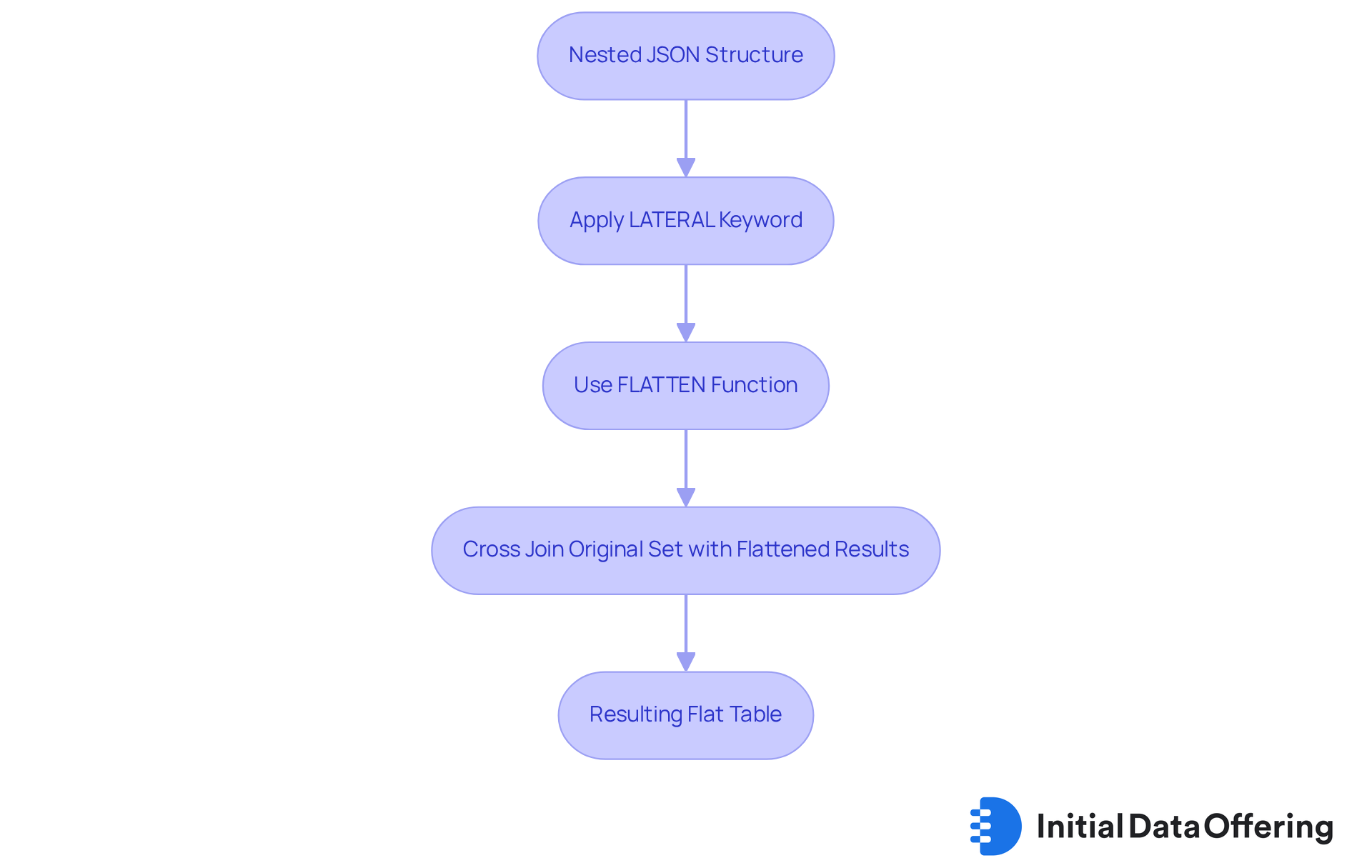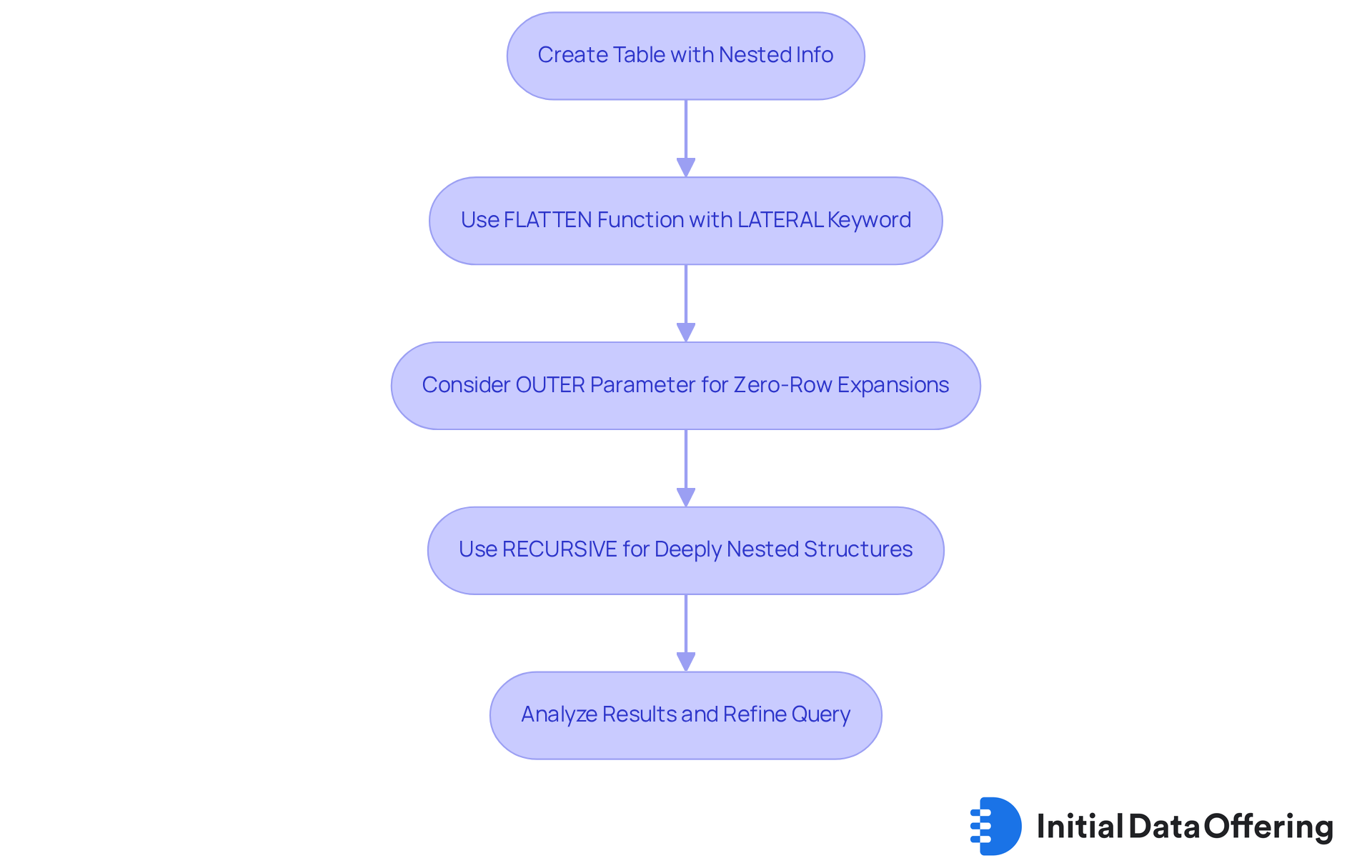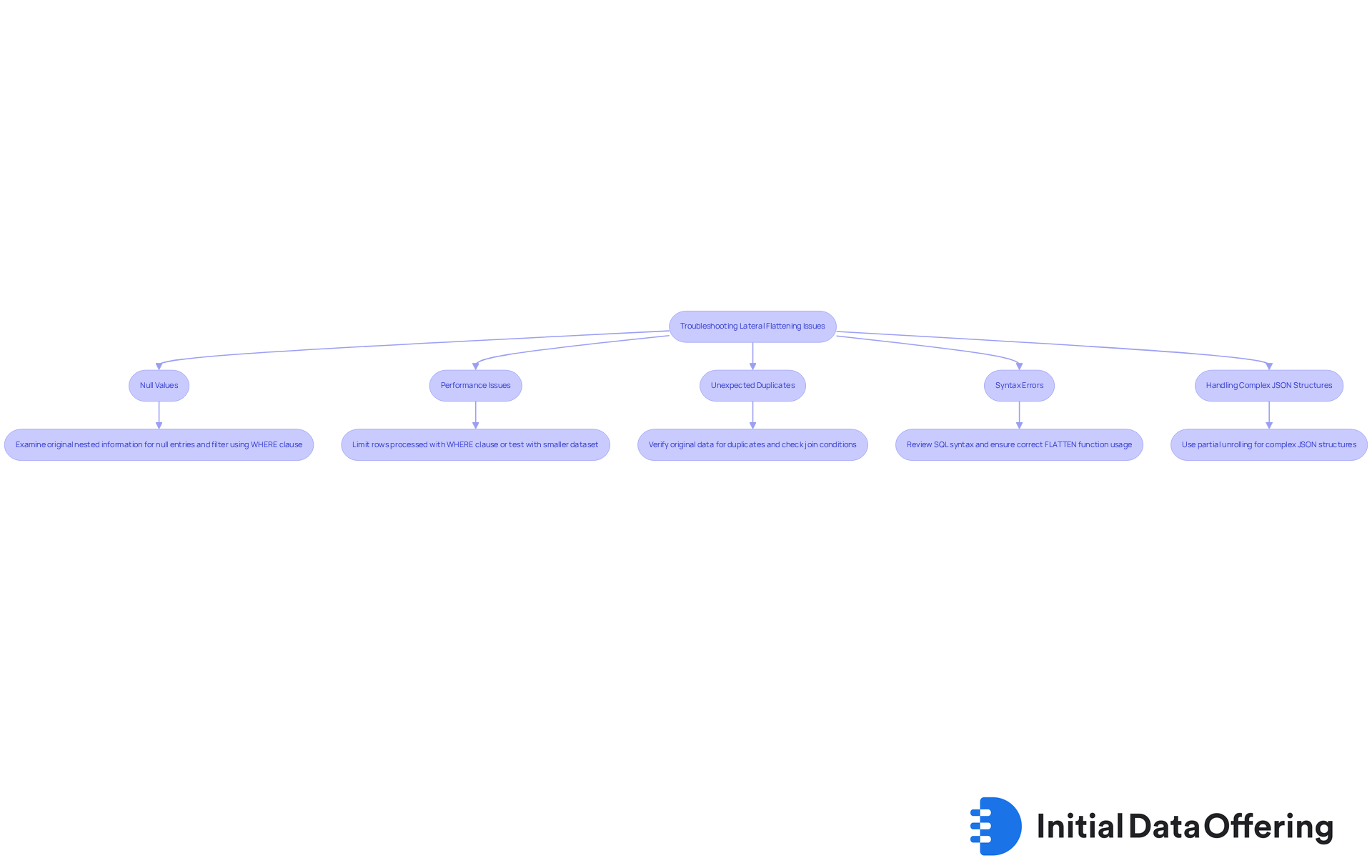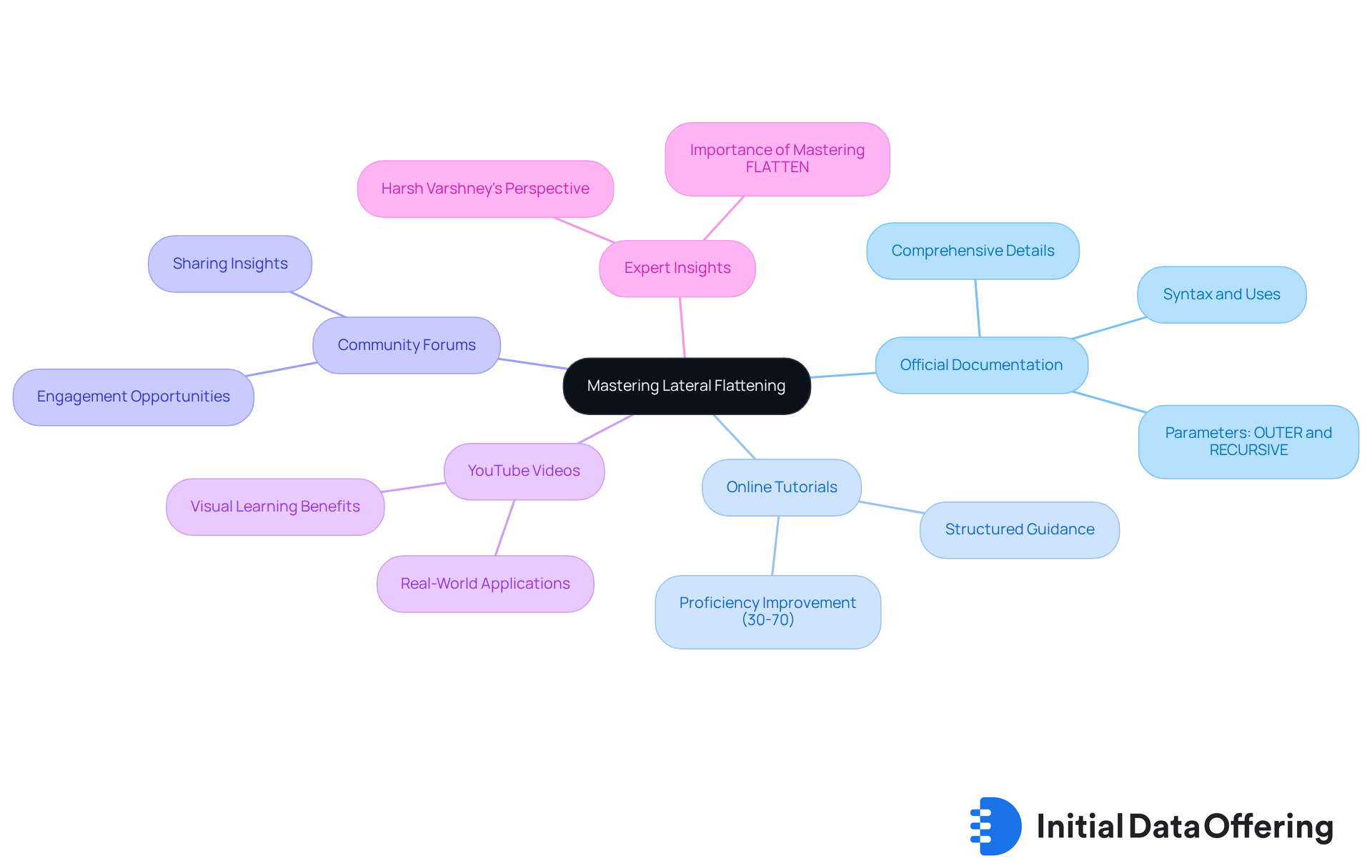Master Lateral Flatten: A Step-by-Step Guide for Analysts

Master Lateral Flatten: A Step-by-Step Guide for Analysts
Overview
This article offers a comprehensive step-by-step guide on mastering the lateral flatten technique in Snowflake. This technique is essential for transforming nested JSON structures into a flat tabular format, which facilitates easier analysis. By detailing the implementation process, it not only addresses common troubleshooting issues but also emphasizes the technique's significance. The benefits of mastering this technique include:
- Enhanced data accessibility
- Efficiency for analysts
- Ultimately improving their analytical capabilities
Introduction
Lateral flattening in Snowflake represents a transformative approach for analysts working with complex, nested data structures, such as JSON arrays. This powerful technique simplifies data manipulation, enhancing the efficiency of querying intricate information.
However, as analysts dive into the nuances of lateral flattening, they may encounter challenges that complicate their workflow.
How can mastering this essential function empower analysts to unlock deeper insights and streamline their data analysis processes? Understanding these complexities is crucial for maximizing the benefits of lateral flattening.
Understand Lateral Flattening in Snowflake
Lateral flatten in Snowflake serves as a powerful technique for transforming nested structures, such as JSON arrays, into a flat, tabular format. This transformation enables analysts to access and manipulate intricate information more easily. The LATERAL keyword allows the FLATTEN function to reference prior rows in a query, effectively forming a cross join between the original set and the flattened results. Understanding this concept is essential for analysts handling semi-structured information, as it facilitates more efficient querying and analysis.
For instance, consider a JSON object containing an array of products. By utilizing lateral flatten, you can extract each product into its own row, which simplifies the analysis of product attributes individually. This technique is particularly advantageous in scenarios where information is deeply nested, as it enhances the structure's accessibility for further analysis.
As Chris Child, VP of Product, Data Engineering at the company, states, "Openflow dramatically simplifies information accessibility and AI readiness." This statement underscores the importance of lateral flatten methods in improving accessibility for analysis. Additionally, with the platform's information ingestion capabilities supporting throughput of up to 10 gigabytes per second, analysts can expect information to be available for querying in as little as 5-10 seconds after ingestion. This significantly boosts the efficiency of information manipulation processes.
The impact of lateral flatten on information accessibility within the platform is profound; it empowers analysts to extract insights more efficiently and effectively. Ultimately, this leads to enhanced decision-making and strategic planning.

Implement Lateral Flattening: Step-by-Step Instructions
To implement lateral flatten in Snowflake, it is essential to follow a structured approach that enhances your data analysis capabilities. Begin by creating a table with nested information, such as JSON. For instance:
CREATE TABLE products (id INT, details VARIANT);
INSERT INTO products VALUES (1, PARSE_JSON('{"name": "Product A", "features": ["Feature 1", "Feature 2"]}'));
This step establishes a foundation for handling complex data structures.
Next, utilize the FLATTEN function in conjunction with the LATERAL keyword to achieve a lateral flatten of the nested structure. Here’s how you can achieve this:
SELECT id, f.value AS feature
FROM products,
LATERAL FLATTEN(input => details:features) AS f;
This query effectively returns each feature of the product in a separate row. The FLATTEN function is adept at managing complex JSON structures, including nested objects and arrays, thus proving to be a versatile tool for data manipulation.
Consider the OUTER parameter if your goal is to include rows that cannot be expanded. This parameter generates one row with NULL values for any zero-row expansions, ensuring that no valuable information is lost during the flattening process. How might this capability impact your data analysis?
Furthermore, for deeply nested structures, employing the RECURSIVE parameter is advisable to ensure all sub-elements are expanded. This approach is particularly beneficial when dealing with intricate information hierarchies, allowing for a comprehensive view of your data.
Once you have executed your queries, it is vital to analyze the results. Review the output to confirm that the information has been flattened correctly, ensuring each feature appears in its own row, associated with the corresponding product ID. This step is crucial for ensuring the lateral flatten of data integrity.
Finally, refine your query as necessary, depending on your analysis needs. You can enhance your dataset by adding filters or joining with other tables. It is important to ensure proper type conversion when extracting values from JSON to avoid type mismatches. By adhering to these procedures, you can efficiently employ lateral flatten to streamline your analysis tasks in the cloud. This technique not only simplifies the handling of complicated structures but also enhances the overall efficiency of your analytical processes.

Troubleshoot Common Issues with Lateral Flattening
When utilizing lateral flatten in Snowflake, analysts may encounter several common challenges that can hinder their workflow. Understanding these issues and implementing effective troubleshooting strategies can significantly enhance the data handling process.
-
Null Values: If your flattened results contain null values, it is essential to examine the original nested information for null entries. You can filter these out using a WHERE clause, as illustrated below:
SELECT id, f.value AS feature FROM products, LATERAL FLATTEN(input => details:features) AS f WHERE f.value IS NOT NULL;This approach ensures that only relevant data is processed, improving the quality of your results.
-
Performance Issues: Flattening extensive datasets can lead to performance bottlenecks. To enhance efficiency, consider limiting the number of rows processed by incorporating a WHERE clause or testing with a smaller dataset. Additionally, employing clustering keys on frequently queried JSON paths can optimize performance, ensuring quicker response times.
-
Unexpected Duplicates: If duplicate rows appear in your results, it is crucial to verify that the original data does not contain duplicates. Furthermore, examining your join conditions can help prevent unintended cross joins, which often lead to redundancy in the output.
-
Syntax Errors: Carefully reviewing your SQL syntax is vital, particularly when using the LATERAL keyword. Ensure that the FLATTEN function is correctly referenced and that all necessary columns are included in your SELECT statement to avoid execution errors.
-
Handling Complex JSON Structures: When dealing with complex JSON structures, it is important to recognize that nested objects and arrays may require specific handling. Consider using partial unrolling to balance performance and flexibility, allowing for more efficient data processing.
By comprehending these typical problems and their remedies, analysts can manage the lateral flatten process with greater efficiency and accuracy, ultimately leading to more reliable data insights.

Explore Additional Resources for Mastering Lateral Flattening
To deepen your understanding of lateral flattening in Snowflake, consider the following resources:
-
The official documentation provides comprehensive details on the operation that condenses data, outlining its syntax and uses, including parameters such as OUTER and RECURSIVE modes. This resource serves as an essential starting point for users, ensuring they grasp the foundational aspects of the FLATTEN function.
-
Online tutorials on platforms like Y42 and Hevo Data offer structured guidance, helping users navigate the effective use of the FLATTEN function. Studies indicate that engaging with such tutorials can lead to a 30-70% improvement in proficiency in SQL functions, significantly enhancing learning outcomes.
-
Community forums, such as Stack Overflow and the Snowflake Community Forum, provide opportunities to connect with fellow users, ask questions, and share insights. How might engaging with this community enhance your learning experience? The exchanges you have can lead to valuable insights that deepen your understanding.
-
For those who prefer visual learning, YouTube provides a variety of tutorials that demonstrate how to lateral flatten. Observing these practical demonstrations not only strengthens comprehension but also showcases real-world applications of the function, making the learning process more relatable.
-
Expert insights are invaluable; according to Harsh Varshney, a research analyst at Hevo Data, "The FLATTEN function in Snowflake refers to a table function that expands nested information like arrays or objects into separate rows." This perspective highlights the importance of mastering this function for efficient information manipulation.
By leveraging these diverse resources, you can effectively enhance your skills in lateral flatten. This empowerment enables you to tackle complex data analysis tasks with confidence, transforming your approach to data management.

Conclusion
Mastering lateral flattening in Snowflake is essential for analysts aiming to efficiently manage and analyze complex, nested data structures. This powerful technique transforms intricate JSON arrays into a flat, tabular format, facilitating easier data manipulation and insight extraction. By leveraging the LATERAL keyword alongside the FLATTEN function, analysts can effectively navigate and analyze semi-structured information, thereby enhancing their decision-making capabilities.
The article outlines a comprehensive step-by-step approach to implementing lateral flattening, beginning with the creation of a table containing nested information and culminating in executing queries that yield flattened results. Key insights include addressing common issues such as:
- null values
- performance bottlenecks
- unexpected duplicates
Alongside practical troubleshooting strategies to ensure data integrity and accuracy. Moreover, the importance of refining queries and utilizing additional resources for deeper learning is emphasized, empowering analysts to tackle complex data challenges with confidence.
Engaging with the techniques and insights presented in this guide not only simplifies the data handling process but also enhances overall analytical efficiency. Embracing lateral flattening as a fundamental skill will significantly elevate an analyst's proficiency in managing semi-structured data. As analysts continue to explore the capabilities of Snowflake, mastering lateral flattening will undoubtedly lead to more informed decisions and strategic planning in their data-driven endeavors.
Frequently Asked Questions
What is lateral flatten in Snowflake?
Lateral flatten in Snowflake is a technique used to transform nested structures, such as JSON arrays, into a flat, tabular format, making it easier for analysts to access and manipulate complex information.
How does the LATERAL keyword function with the FLATTEN function?
The LATERAL keyword allows the FLATTEN function to reference prior rows in a query, effectively creating a cross join between the original dataset and the flattened results.
Why is understanding lateral flatten important for analysts?
Understanding lateral flatten is essential for analysts dealing with semi-structured information, as it facilitates more efficient querying and analysis of complex data structures.
Can you provide an example of how lateral flatten is used?
For example, if you have a JSON object containing an array of products, lateral flatten can be used to extract each product into its own row, simplifying the analysis of individual product attributes.
What are the benefits of using lateral flatten for data analysis?
Lateral flatten enhances the accessibility of deeply nested information, allowing analysts to extract insights more efficiently and effectively, which ultimately leads to improved decision-making and strategic planning.
How does the platform's information ingestion capabilities relate to lateral flatten?
The platform supports information ingestion at a throughput of up to 10 gigabytes per second, with data becoming available for querying in as little as 5-10 seconds after ingestion, significantly boosting the efficiency of information manipulation processes.